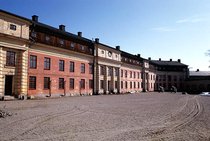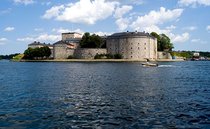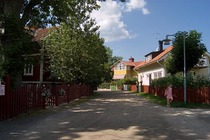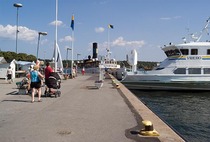Vaxholm town and fortress
Vaxholm is a centre of summer activity in the Stockholm archipelago and its only town, founded as long ago as 1647. The town bears the marks of its military history, shown by the Vaxholm Fortress and the many wooden houses typical of the period around the turn of the century at 1900, highly decorated with carpentry.
The town of Vaxholm grew from a defence establishment whose construction started on neighbouring Vaxholmen in 1548. As early as the 16th century, the fortress led to a certain amount of construction on Vaxön.
Largest town in Roslagen
It is traditionally believed that Vaxholm was granted rights as a town in 1647, but extensive research has not been able to find any document that confirms this. What is known, however, is that the inhabitants in Vaxholm had the right to conduct commerce and establish inns at a very early date. The land was crown property right up until 1930, and the maximum length of a lease granted was 30 years. For much of the 20th century, the inhabitants lived mainly from fishing, although some employment opportunities came from trade, piloting boats through the archipelago, and work at the fortress. Approximately 500 people lived here in 1786, not counting the garrison, and this made it the largest town in Roslagen.
Vaxholm Fortress
The only approaches to Stockholm that large vessels can take through the archipelago have passed Vaxholm since the 16th century, either by Kodjupet north of the town or by Oxdjupet between Rindö and Värmdö. Several defence facilities, known collectively under the name “Vaxholm Fortress”, have been built through the ages to protect these approaches. The defence facility at Vaxholm that controlled Kodjupet was given a stone tower and protective earthworks at an early date, while Fredriksborg at Oxdjupet was not completed until 1735. During the years 1833-63, the fortress at Vaxholm was replaced by what is now Vaxholm Citadel, which was planned as defence of the Vaxholm Strait in combination with Rindö redoubt, built in 1858-63. Unfortunately, the defence works proved to be out-of-date as soon as they were completed. The stone walls of the Vaxholm Citadel were no match for the new rifled cannon barrels that had been invented during the 1860s. The problem was solved by blocking off Kodjupet, and the subsequent construction of a new modern defence facility known as Oscar Fredriksborg during the period 1870-77 at Oxdjupet, which was now the only approach to Stockholm. However, this facility also soon became obsolete, and the defence line for Stockholm was transferred farther out into the archipelago during the First World War.
Summer paradise for Stockholmers
The islands at Vaxholm have had regular boat connections with Stockholm since 1836, when the Stockholm-Mariefred steamer route was established. Vaxholms Ångfartygs AB was founded in 1869, with frequent traffic throughout the archipelago. During the latter part of the 19th century, the islands of the inner archipelago were transformed into a summer paradise for the rich bourgeoisie of Stockholm. Vaxholm became a meeting place for the wealthy, as can still be seen in the architecture of the buildings, which mainly consist of wooden houses with the richly decorated carpentry that was typical for the period.
It was not until 1926 that Vaxholm acquired a permanent land connection to Stockholm, when the bridge over Pålsund was opened. Before this, boat traffic had dominated, although the growth of road traffic was starting to force the construction of better roads and new bridges. Until 1912, it was only permitted to build wooden houses in Vaxholm. The idea was that it should be possible to rapidly burn down the houses in the event of an enemy attack, in order to prevent the attackers benefiting from them. A further renewal of Vaxholm has occurred in the post-war period. Older buildings have given place to department stores, blocks of flats, and car parks. In the area around Norrhamn, in particular, it is still possible to experience the old wooden town before the era of summer guests took over.
Links
Vaxholm in Roslagen
Upplev Vaxholm
Bus and boat connections with Stockholm.





